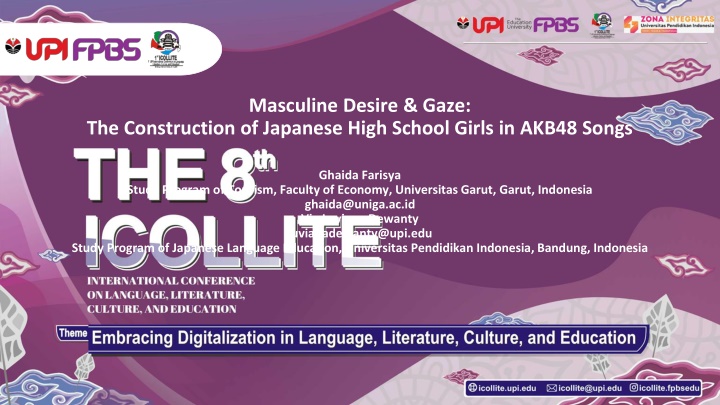
Construction of Japanese High School Girls in AKB48 Songs
Explore the portrayal of high school girls in AKB48 songs through the lens of masculine desire and gaze, shedding light on how these young performers navigate authenticity, commodification, and objectification in the J-pop music scene.
Download Presentation

Please find below an Image/Link to download the presentation.
The content on the website is provided AS IS for your information and personal use only. It may not be sold, licensed, or shared on other websites without obtaining consent from the author. If you encounter any issues during the download, it is possible that the publisher has removed the file from their server.
You are allowed to download the files provided on this website for personal or commercial use, subject to the condition that they are used lawfully. All files are the property of their respective owners.
The content on the website is provided AS IS for your information and personal use only. It may not be sold, licensed, or shared on other websites without obtaining consent from the author.
E N D
Presentation Transcript
Masculine Desire & Gaze: The Construction of Japanese High School Girls in AKB48 Songs Ghaida Farisya Study Program of Tourism, Faculty of Economy, Universitas Garut, Garut, Indonesia ghaida@uniga.ac.id Via Luviana Dewanty luvianadewanty@upi.edu Study Program of Japanese Language Education, Universitas Pendidikan Indonesia, Bandung, Indonesia
INTRODUCTION The members of AKB48 range in age from 12 to 29 years old. While the younger members naturally embody a girlish image, the older members may need to exaggerate this aspect. This is evident in their performance style, which resembles a school choir rather than individual performers, their choice of songs about friendship, school, young love, sweets, and flowers, and their attire, often consisting of school uniforms or music videos filmed in schoolyards (Keith and Hughes, 2016) AKB48 encapsulates the ways in which female performers in Japanese rap, punk, and pop music genres struggle with issues of authenticity, commodification, and objectification. As young girls designed and managed by men, their performances are dictated by stereotypical performance markers of youthful femininity and innocence, regardless of their age or target audience. The commodification and authenticity of their performances are constantly criticized, even within the pop idol world. In the analysis of five summer music videos from the Japanese idol group AKB48, Chandra and Mochtar (2022) argue that the videos depict the group members as alluring, seductive, and playful. This portrayal, which often focuses on specific body parts. This research discusses how high school girls are represented in AKB48's song lyrics based on the Oricon Chart from a heterosexual male's perspective. These studies demonstrate how the male gaze operates across different cultural contexts and media forms, shaping the representation of women and influencing societal perceptions of female beauty and sexuality.
LITERATURE REVIEW Research on the male gaze in Korean pop culture or K-pop has been conducted the past few years. The results of the discussion show that women's perceptions of themselves and beauty standards. They argue that K-pop culture, which often features female idols with strict beauty standards, can reinforce the idea that women must meet certain standards to be considered beautiful. These beauty standards can cause anxiety in women (Chen & Zhang, 2023). Male gaze women are typically depicted as passive objects of male desire, while men are positioned as active subjects who possess the power of the gaze (Mulvey, 1975). This gaze objectifies and sexualizes women, reducing them to their physical appearance and reinforcing traditional gender roles. In the context of the provided articles, the male gaze is explored in various forms of media and cultural contextsSuch as song lyric. Male gaze in song lyric adalah istilah yang digunakan untuk menjelaskan bagaimana perempuan direpresentasikan dalam seni visual dan literatur dari sudut pandang laki-laki heteroseksual. Dalam konteks lirik lagu, male gaze dapat terlihat dalam bagaimana lirik tersebut menggambarkan perempuan sebagai objek hasrat seksual laki-laki (Chen & Zhang, 2023; Chandra & Mochtar, 2022; Loreck, J. , 2016; Previous research has the topic of reggaetoneras, female singers in the notoriously sexist genre of reggaeton music. G mez Arrieta and Miller (2023) focused on Becky G, a reggaetonera who claims to be a feminist. They analyzed the music video "Sin Pijama" and found that although the lyrics speak of female empowerment, the visuals in the video still follow patriarchal norms and fulfill male fantasies. This article highlights the contradiction between empowering lyrics and objectifying visuals in reggaeton.. Focus on specific body parts Uses objectifying language Depicts women as passive objects
METHOD 1. Find the lyrics of the AKB48 song with the theme of high school students in Oricon Chart (The Most popular song awards in Japan) 2. Translate and identify representation of high school girl in song lyrics 3. classify the song verses in 5 AKB48 song lyrics about Japanese high school teenagers 4. Analyze data use male gaze Theory 5. conclusions Qualitative Method
FINDING AND DISCUSSION 1, Skrit hirari Seifuku ga Jama o suru 2.Sakura no ha abita ya hi 3. Sakura no kininarou 4. Iiwake maybe 5.Teacher Teacher 6. Sentimental train
CONCLUSION This research argues that these featured women not only reflect women's physical attributes as objects of sexual desire, but also reinforce existing gender norms in Japanese society. The research concludes that ignoring the complexity of teenage girls' experiences and emotions can potentially limit teenage girls' aspirations, expressions, and opportunities for growth. It is hoped that this research can be developed in future studies using more robust methodologies such as deploying surveys and interviews to understand how Japanese society interprets and responds to Japanese popular song lyrics.
REFERENCES Cahoon, K. (1993).Japan: An Illustrated Encyclopedia Tokyo: Kodansha. Chandra, J. A., & Mochtar, J. (2022). Sexualized Depictions of AKB48 Girls in Their Summer Music Videos. Kata Kita, 10(3), 579 586. Chen, S., & Zhang, Y. (2023). Bondage of Standard: Interaction Between K-Pop Culture and Male Gaze. Proceedings of the 4th International Conference on Educational Innovation and Philosophical Inquiries. Cole, M. W. and Zorach, R. (2009). The Idol in The Age of Art: Objects, Devotions and the Early Modern World. Routledge. Kinsella, S. (1995). Cuties in Japan. In L. Skov & B. Moeran (Eds.), Women, media, and consumption in Japan (ConsumAsiaN book series). (pp. 220-255). Curzon Press. Galbraith, P. W. (2012). Idols: the image of desire in Japanese consumer capitalism. In Idols and Celebrity in Japanese Media Culture, edited by Galbraith, P. W. and Karlin, J. G., pp. 185-208. Palgrave Macmillan. Galbraith, P. W. (2017). AKB business: idols and affective economics in contemporary Japan. In Introducing Japanese Popular Culture, edited by Freedman, A. and Slade, T., pp. 158-167. Routledge. G mez Arrieta, N., & Miller, T. (2023). Reggaetoneras: undermining or embracing male fantasy? Feminist Media Studies, 23(8), 3832 3847. Katsuki, T. (2014). Aidoru no yomikata: konransuru katari o tou. Seikyusha. Lin, Y. C. and Lin, C. H. (2007). Impetus for worship: an exploratory study of adolescents idol adoration behavior. Adolescence 42(167): 575-588. Nishiyama, Y. (2016). But Iam Still a Girl After ALL: A Discourse Analysis of Femininities in Popular Japanese Manga Comics. Victoria University of Wellington McVeigh, B. (1996). Commodifying affection, authority and gender in the everyday objects of Japan. Journal of Material Culture, 1(3), 291-312. Miller, L. (2004). You are doing burikko!: Censoring/scrutinizing artificers of cute femininity in Japanese. In S. Okamoto & J. S. S. Smith (Eds.), Japanese language, gender, and ideology: Cultural models and real people (pp. 148-165). Oxford University Press. Mils. S (1997). Discours. Routledge Schutz, U.G. (2015). What Text Can Tell Us About Male and Female Characters in Shojou and Shounen Manga. EAJPC. DOI:10.1386?eapc.1.133_1 Tajima, Y. (2018). Japanese idol culture for contents tourism and regional revitalization: a case study of regional idols. In Global Leisure and the Struggle for a Better World, edited by Beniwal, A., Jain, R. and Spracklen, K., pp. 117-139. Palgrave Macmillan. Van-Haecke, P. J. (2020). Female idols in Japan: desiring desire, fantasmatic consumption and drive satisfaction. East Asian Journal of Popular Culture 6(1): 77-92. Yamamoto, S. (2019). Japanese Female Aidoru Identities. The University of Arizona. [A Dissertation Submitted to the Faculty of the DEPARTMENT OF EAST ASIAN STUDIES]. Yu, S. (2017). Japanese Anime and Woman s Gender-Role Changing. Jyv skyl University. [A Thesis Submitted to the Faculty of Humanities]
Follow us @... THANK YOU!






















